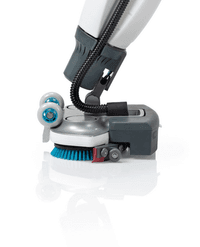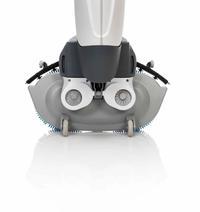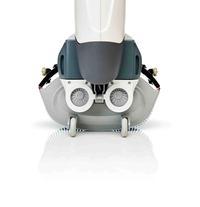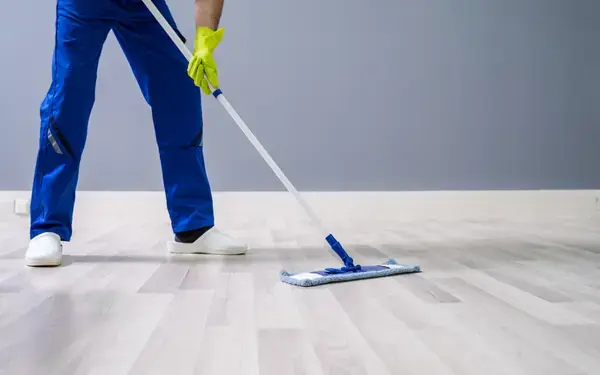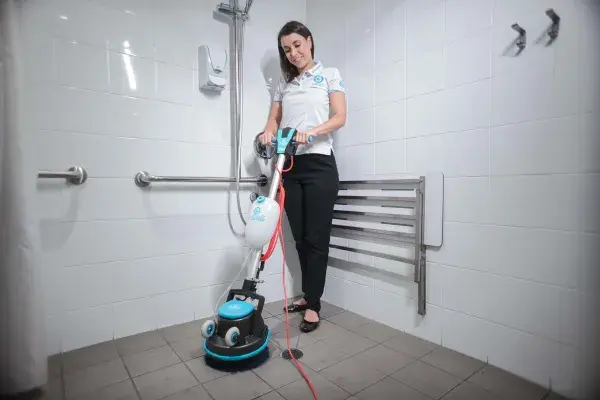You are reading: How To Remove Heavy Soil Buildup in Warehouses and What Actually Works?
03 July 2025
7min read time
Brooke Payne
How To Remove Heavy Soil Buildup in Warehouses and What Actually Works?
Share:

Key Insights
- Automated Scrubbers Save Time and Improve Safety: Automated floor scrubbers, including ride-on and orbital scrubbers, significantly reduce cleaning time while improving safety. These machines clean large areas efficiently by dispensing fresh water, scrubbing the floor, and suctioning up dirty water—all in one pass. This eliminates the need for manual cleaning, reduces operator fatigue, and enhances productivity.
- Orbital Scrubbers Provide Superior Cleaning Efficiency: Orbital scrubbers combine orbital motion and high-speed rotation to provide multiple cleaning passes per minute. This results in more effective and faster cleaning, without leaving swirl marks or streaks. They are also safer and easier to handle compared to rotary scrubbers, offering enhanced control and maneuverability, especially in tight spaces or on dry floors for buffing.
- Regular Maintenance and Spill Response Are Essential for Long-Term Efficiency: Proactively managing soil buildup, maintaining cleaning equipment, and responding immediately to spills are critical to maintaining floor cleanliness and safety. Investing in automated scrubbers and using the right chemicals helps prevent soil accumulation, while routine maintenance extends the life of cleaning equipment and ensures consistent performance.
Warehouse floors are continuously exposed to heavy traffic, dust, oils, spills, and debris, leading to a significant buildup of soil. Over time, this not only detracts from the cleanliness of the warehouse but also poses safety risks and hampers operational efficiency.
Effective cleaning is crucial for ensuring floors remain safe, clean, and conducive to productivity. In this guide, we’ll walk through the methods and tools that actually work for removing heavy soil buildup, focusing on high-performing, ergonomic equipment and systematic approaches.
Understanding Heavy Soil Buildup in Warehouses
Before we dive into the cleaning methods, it's essential to understand what you’re up against. Warehouse floors are exposed to unique contamination sources that cause heavy soil accumulation.
Common contaminants include:
- Oil and Grease: Forklifts, machinery, and hydraulic equipment often leak oil and grease, creating slippery spots on floors. These oils are not only hazardous but difficult to remove if left untreated. Different types of oils, such as motor oil, hydraulic fluid, and grease from machinery, require specialized degreasers and mechanical agitation to emulsify and lift them from the floor.
- Dust and Debris: Warehouse floors are subject to constant foot traffic, product handling, and pallet movement, all of which bring dirt and debris. Over time, fine dust can settle on the floor, mixing with moisture and oils, creating a sticky, abrasive mess. Regular sweeping or vacuuming prevents these contaminants from building up into harder-to-clean layers.
- Chemical Spills: Warehouse environments frequently use various chemicals, from cleaning agents to battery acid. These spills, if not cleaned promptly, can cause long-term damage to the floor, create safety hazards, and contribute to workplace injury risks. For example, battery acid spills require neutralizing agents to prevent floor degradation.
- Water: Areas near loading docks or warehouses in wet climates often deal with water buildup. When mixed with oils, dust, and debris, water can create a hazardous, slippery surface. Implementing systems to capture rainwater or excess water at entry points can prevent these conditions.
Understanding how contaminants affect the floor and interact with different floor types (e.g., epoxy, concrete, vinyl) is essential for choosing the right cleaning method.
Daily Cleaning: A Routine That Actually Works
A structured daily cleaning schedule is crucial to prevent soil from accumulating. Here’s what works:
1. Use Automated Scrubbing Machines
The foundation of an effective cleaning routine is using automated floor scrubbers . These machines lay fresh water, scrub the floor with brushes or pads, and suction up the dirty water into a tank. This method leaves floors dry, safe, and clean in record time. Automated scrubbers save significant time compared to manual methods and are far more efficient for large areas.
For heavy soil buildup, orbital scrubbers are an ideal choice for removing tough grease and oil. They can be used for both daily and deep cleaning, ensuring that grime doesn’t accumulate and create safety hazards. These scrubbers not only improve floor safety but also enhance the overall cleanliness of the warehouse, providing a consistently professional appearance.
2. Spot-Clean Spills Immediately
Spills, especially oil, water, or chemical substances, should be cleaned up immediately to prevent them from becoming a more significant issue. Spill kits should be used to quickly address liquid spills. Choose the right degreasing chemicals for stubborn oil and grease buildup. Heavy-duty scrubbers with the right scrub pads can lift oils from the floor, emulsifying them effectively.
3. Edge Cleaning
Look for scrubbers with edge-cleaning features. Many modern automated scrubbers are equipped to clean along the edges of floors, where soil often accumulates. Ensuring that your scrubber has this capability will save you from needing to rely on secondary cleaning methods. Some machines even feature tight-space cleaning capabilities for areas around racks and shelves. Ensure you do your research when purchasing a floor scrubber to check that they have these capabilities.
4. Use Floor Mats to Reduce Contamination
Preventative measures, such as investing in high-quality entrance mats , reduce the amount of dirt and moisture that enters the warehouse. These mats absorb contaminants, minimizing the amount of soil that ends up on the floor. Over time, this reduces the overall cleaning burden and ensures less frequent deep cleanings.

Weekly Cleaning: Staying Ahead of the Build-Up
For larger warehouses, weekly deep cleaning is essential. With the right equipment, this doesn’t have to be time-consuming.
1. Automated Scrubbers for Large Areas
Automated scrubbers work well for both daily maintenance and deep cleaning. These machines are ideal for larger warehouse areas, covering massive spaces quickly. For large facilities, ride-on scrubbers or scrubber-sweepers help cover vast spaces efficiently, eliminating the need for additional equipment.
2. Heavy-Duty Cleaning for Stubborn Contaminants
In areas where grease, oils, and spills accumulate frequently, a heavy-duty scrubber is essential. Use specialized degreasers along with with your commercial floor cleaner to break down and lift these contaminants. For some areas, a pressure scrubber can be useful, but make sure to follow up with a recovery system to vacuum up excess water and contaminants. These scrubbers not only save time but also improve safety by eliminating slip hazards.
Implementing an Efficient EOD Cleaning Schedule
Not all floor cleaning needs to be reserved for weekly or monthly sessions. In large warehouses, you can implement an End-of-Day (EOD) cleaning schedule. With ride-on scrubbers, daily cleaning can be done quickly, covering high-traffic areas in no time. Using automated machines like these for daily cleaning ensures a consistently clean environment without the need for long and disruptive cleaning sessions.
With high-performance equipment, you can easily prevent soil buildup by performing quick cleanings each day. This reduces the need for long, intensive cleaning sessions and saves both time and money in the long run.
Chemical and Equipment Selection: What Actually Works
The right combination of chemicals and equipment ensures a cleaner floor and a more efficient process. Here's what works best for removing heavy soil buildup:
Daily Cleaning Chemicals: A neutral floor cleaner works well for regular daily cleaning. For tougher stains and spills, use alkaline degreasers. These chemicals are designed to break down oils and grime effectively.
Heavy-Duty Cleaning Chemicals: For more stubborn grease, oil, and chemical spills, a strong alkaline degreaser is necessary. Make sure to let the product dwell on the floor for a few minutes before scrubbing to break down the contaminants. Always follow the manufacturer’s instructions on dilution ratios.
Choosing the Right Equipment: Automated scrubbers are essential for large-scale cleaning, as they lay water, scrub, and suction up dirty water efficiently. Look for machines that are ergonomically designed and capable of cleaning tight spaces and edges effectively.
Helpful Resources
Here are some additional resources to help you make the most of your floor cleaning efforts:
How to Select a Floor Scrubber – A guide on choosing the right floor scrubber for your warehouse cleaning needs.
How to Choose the Right Floor Scrubber for an Industrial Workshop – Find the best scrubber for industrial environments.
The Importance of Ergonomics in Floor Cleaning – Watch how ergonomic scrubbers can reduce strain and improve productivity in the workplace.
What You Should Look For I An Industrial Floor Mop – Learn more about efficient Industrial cleaning practices and why using automated scrubbers is key to reducing labor and improving safety.
Cost Control: Clean Efficiently, Save More
A clean warehouse is an investment in productivity and safety. However, the right equipment will help keep cleaning costs down. Here’s how you can reduce overall expenses:
Invest in the Right Equipment: Although automated scrubbers may require a larger initial investment, they save significant time and reduce labor costs. By having the right equipment, you’ll avoid costly, time-consuming deep cleanings.
Training: Ensure your cleaning team is well-trained to use the equipment effectively. Efficient operation reduces mistakes and maximizes the lifespan of the machines.
Maintenance: Preventive maintenance of your cleaning equipment ensures it operates at full efficiency, extending its lifespan and avoiding costly repairs.

Safety and Compliance Considerations (OH&S)
Maintaining clean floors is not only about safety but also about compliance with Work Health and Safety (WHS) regulations. In Australia, employers must take necessary precautions to prevent slip-and-trip hazards. Effective floor cleaning and immediate spill response are key parts of these safety measures.
Slip and Trip Prevention: Regularly inspect the floor for slick spots or loose materials. Wet floor signs should be used whenever cleaning is taking place.
Chemical Safety: Store and use chemicals according to the manufacturer’s guidelines. Ensure that all staff use proper Personal Protective Equipment (PPE) during cleaning.
Training: Training staff in using the machines properly reduces accidents and improves the overall cleaning process.
Conclusion
Removing heavy soil buildup in warehouses doesn’t have to be difficult. With the right approach and equipment, it can be done efficiently and cost-effectively. By focusing on what actually works, you can reduce downtime, improve safety, and keep your warehouse in top condition. Consistent cleaning using the best tools will save you time and money in the long run, helping you create a cleaner, safer, and more productive environment.
To book a demo with one of our commercial floor cleaning machines, click here!
Products Featured Inside this Article
Media and Insights
Join the movement that's changing what clean means.
Be part of a cleaner world. Get a live demo at a time that suits you.
Book a Demo